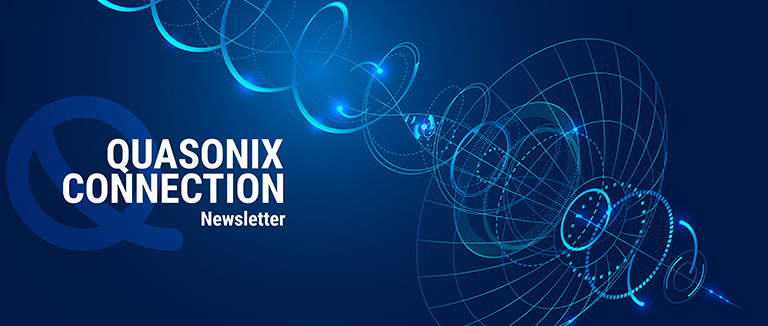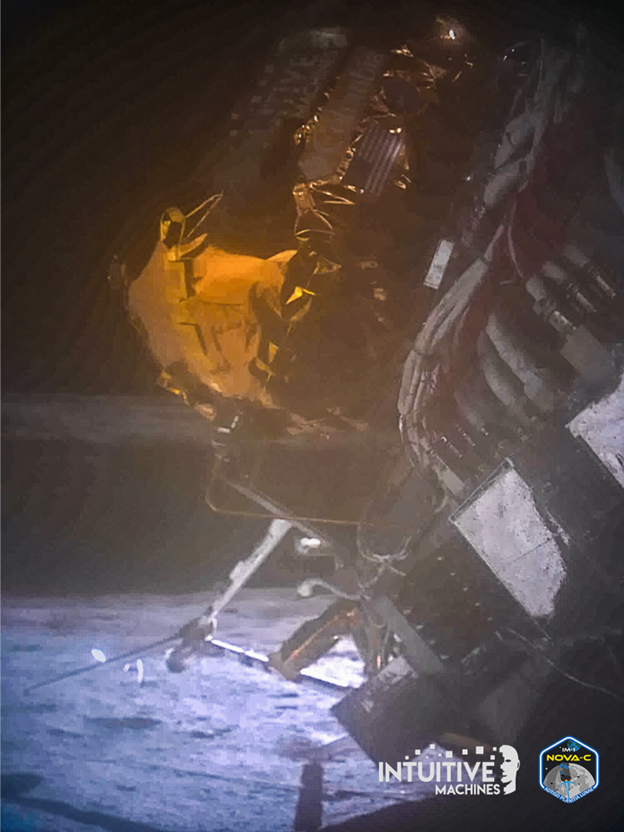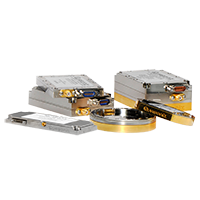
News from the company that’s…
Reinventing Telemetry™
April, 2024
In this issue:
Quasonix is On the Moon
Quasonix is proud to be an integral part of Intuitive Machines’ recent IM-1 mission Moon landing.
The mission was highly successful, overcoming many obstacles, including a difficult touchdown that resulted in the lander, named Odysseus, tipping mostly on its side. This unplanned orientation reduced the exposure of the lander’s solar panels to the sun, producing a fraction of the expected power. The lander’s attitude also pointed the high-gain antenna at the lunar surface instead of the earth. Because the high-gain antenna was unusable, four low-gain hemi antennas were used for data transmission.
Odysseus used a Quasonix transmitter to send science and engineering data to Earth, captured by a network of large radio astronomy dishes around the world. The transmitter used is part number QSX-VSR4-0101-25-80-04AB-CE-VP, a 25-watt S-band unit with SOQPSK and BPSK/QPSK/OQPSK modulations (use of OQPSK was planned for the mission), equipped with Convolutional Encoder (1/2 rate with K=7) and Variable Power (31 settings spanning 24 dB).
Despite the suboptimal antenna array and severe multipath, more than 1.7 gigabytes of science and engineering data was collected across all payloads. The available solar energy was initially considered insufficient to fully power the lander and the transmitter for the full mission. Nonetheless, our efficient transmitter was downloading data right up to lunar nightfall, concluding seven days of lunar surface operations.

Credit: Intuitive Machines
This was the first U.S. soft landing on the Moon in more than 50 years, but the mission is being hailed as a triumph for much more than that. In addition to successfully proving a number of technological breakthroughs, this was the first commercial Moon landing ever – a harbinger of costs an order of magnitude lower than government-operated programs.
The Quasonix transmitter used by Intuitive Machines fits neatly into that equation. It was an unmodified COTS product – the same as any other customer could buy. Read on to learn more about how we’ve got the right transmitter for your needs.

Gen 4 Transmitters:
Available in a Configuration for You
First introduced in 2021 in select units, Quasonix’s fourth generation of transmitters is now shipping across all configurations.
This new breed of transmitters builds on the unparalleled performance, value, and durability of our legacy units, adding numerous improvements like better DC-to-RF efficiency and reduced operating current draw, better BER at low and high bit rates, improved reliability and availability of components, support for bidirectional EVTM, and the extension of LDPC to include all six LDPC codes (versus one in the Gen 3 family). You can read more about the huge advantages of LDPC coding here.
Take your telemetry to the next level – even if that’s to the Moon. Contact Quasonix today to learn more.
ITC Highlight Reel
It’s hard to believe that we’re almost midway between last year’s ITC and the 2024 conference. While we’ve got a lot planned for the future, we want to take a few minutes to look back at some “greatest hits” from 2023.

This is the part of the newsletter where a lot of companies would show off the products that were popular at ITC. (Don’t worry, we’ll cover a couple of sensational new products for you in a minute.) But Reinventing Telemetry™ starts with great thinking.
Papers and Awards
Mark Geoghegan is no stranger to ITC, nor to accolades for his papers. This year, Mark scored his third “Best Paper” award for Data Quality Metric (DQM) – How Accurate Does it Need to Be? The paper “investigates the MLBD [Maximum Likelihood Bit Detection] performance loss caused by DQM estimation error. The objective is to gain insight into the sensitivity of the overall bit recovery system and to use the results to help establish tolerance levels in DQM test procedures. This relationship provides the means to guarantee that the DQM accuracy is sufficient to meet or exceed a specified level of system performance which is the goal of DQM testing.”
Sean Wilson, a product leader for Quasonix EVTM, was involved in two papers and presented Ethernet via Bidirectional Packet Based Telemetry – Frequency Division Duplex (FDD) vs. Time Division Duplex (TDD). This analysis, founded on in-depth lab testing, “identifie[s] some key tradeoff areas to be considered when selecting between two bidirectional telemetry link approaches.” Spoiler alert: There’s no single best solution. Sean (and Quasonix) are here to help you make the best decision for your particular situation.
Terry Hill, President of Quasonix, presented Meaningful G/T Measurements – Made at Night. “The conventional method of measuring G/T for directional antennas seems simple: measure received power while pointing the antenna at the sun, repeat the measurement while pointed at ‘cold sky’, and do a few simple calculations. This paper briefly summarizes the many sources of error in this technique and then presents an alternative approach using a calibrated signal source instead of the sun…. The proposed approach can be applied to any type of receiving system (including active antennas and multi-beam phased arrays) and yields G/T results that apply meaningfully to the link budget.”
Products
This year, Quasonix debuted our Maximum Likelihood Stream Combiner™ (MLSC™) and its sister product, our Best Source Selector Analyzer (BSSA).

The MLSC is a new approach to Best Source Selection that extracts optimal data from multiple received signals. Brought to you by the engineering team that developed the industry’s premier Best Channel Selector, the MLSC leverages an industry-leading implementation of Data Quality Encapsulation (DQE) plus Maximum Likelihood Bit Detection (MLBD) and proprietary Quasonix algorithms to improve your received data accuracy under the most challenging conditions.
MLBD is only optimal if all received data streams are able to participate in the combining process at all times. This requires seamlessly maintaining stream alignment at the bit level, while tracking signals through the deep fades that are typical of serial streaming telemetry channels, and almost instantly reacquiring and realigning those streams that lose lock. The resulting system can easily track Doppler rate differentials due to the fastest of targets, well above Mach 25.
Not only does the MLSC derive the lowest achievable output bit error rate possible, it also constructs accurate DQM for the output stream, which can be used in cascaded MLSC™ arrangements or by other downstream equipment.
The net result of using the Quasonix MLSC is huge performance gains – greater than 6 orders of magnitude in BER over the BER of the best single stream, given 8 streams with BERs between 10% and the best single stream.
“If Quasonix is going to build a source selector, we’re going to make sure it’s the best it can be. The BSSA is the equipment that makes that possible.”
The BSSA is a unique tool that emulates real-world channel conditions across all received signals in a range, allowing precise, repeatable BSS testing. This capability enabled rigorous analysis and honing of the MLSC throughout its development.
The BSSA makes it possible to evaluate the performance of different BSS units or settings, allowing you to compare results against theoretical best achievable performance. Its 12 independent data generators are capable of emulating a multitude of best source selection challenges such as channel delay, Doppler effects, variable bit error probability, receiver sync loss, and more. Twelve PCM I/O and twelve TMoIP I/O are independently configurable as input or output, with the ability to monitor and report results for up to four simultaneous channel groups. Tests are precisely repeatable down to the last bit, so it’s easy to make valid comparisons of any equipment across a wide variety of scenarios.
Contact Quasonix to learn more about one or both of these exciting new offerings.
